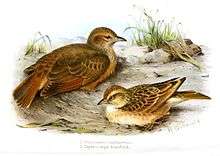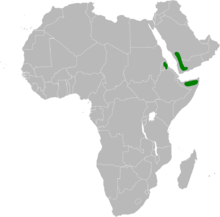Blanford's lark
| Blanford's lark | |
|---|---|
 | |
| C. blanfordi (bottom, right) | |
| Not recognized (IUCN 3.1) | |
| Scientific classification | |
| Kingdom: | Animalia |
| Phylum: | Chordata |
| Class: | Aves |
| Order: | Passeriformes |
| Family: | Alaudidae |
| Genus: | Calandrella |
| Species: | C. blanfordi |
| Binomial name | |
| Calandrella blanfordi (Shelley, 1902) | |
 | |
| range | |
Blanford's lark[1] or Blanford's short-toed lark (Calandrella blanfordi) is a small passerine bird of the lark family, Alaudidae, which is native to north-east Africa and Arabia. Its common name commemorates the English zoologist William Thomas Blanford.
Description
It is 14–15 centimetres long. The upperparts are pale sandy-brown with some darker streaking and the crown is rufous. The underparts are pale and plain apart from a small dark patch on the side of the neck made up of vertical streaks. The greater short-toed lark is similar but has a greyer, more-streaked crown. Erlanger's and red-capped larks have darker upperparts with more streaking and a darker rufous crown. Erlanger's lark has larger dark neck-patches while in red-capped lark the patches are rufous.
Blanford's lark has a sparrow-like flight-call. The song is given in a circular song-flight and includes a mixture of chew-chew-chew-chew notes and fluid phrases.
Habitat and movements
They occur on open stony plains, often with bushes. In Arabia, it breeds between 1800 and 2500 metres above sea-level with some birds dispersing to lower ground in winter. The species is often seen in flocks outside the breeding season.
Taxonomy
It was formerly included in either the greater short-toed lark (C. brachydactyla) or the red-capped lark (C. cinerea) but is now commonly treated as a separate species. Erlanger's lark (C. erlangeri) is sometimes included in this species.
Subspecies
There are three subspecies: C. b. blanfordi in Eritrea, C. b. daaroodensis in northern Somalia and C. b. eremica in Yemen and south-west Saudi Arabia.
References
| Wikispecies has information related to: Calandrella blanfordi |
- ↑ ENGLISH NAME UPDATES - IOC Version 2.9 (July 10, 2011), IOC World Bird List
- Arlott, Norman (2007) Birds of the Palearctic: Passerines, HarperCollins, London.
- Beolens, Bo & Watkins, Michael (2003) Whose Bird?: Men and women commemorated in the common names of birds, Christopher Helm, London.
- Hollom, P. A. D.; Porter, R. F.; Christensen, S. & Willis, Ian (1988) Birds of the Middle East and North Africa, T & AD Poyser, Calton, England.
- Sinclair, Ian & Ryan, Peter (2003) Birds of Africa south of the Sahara, Struik, Cape Town.